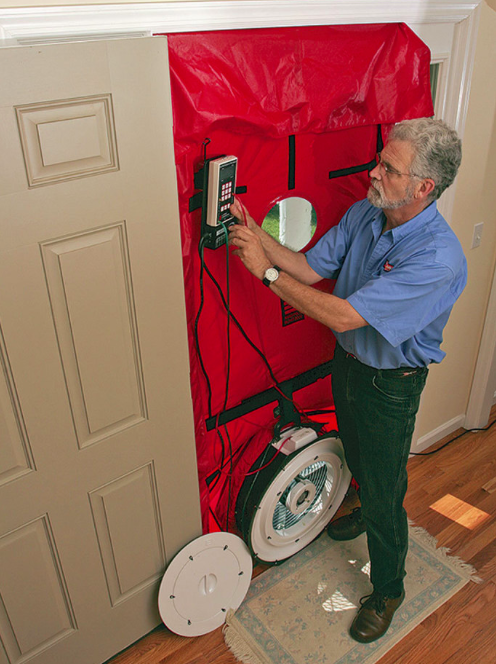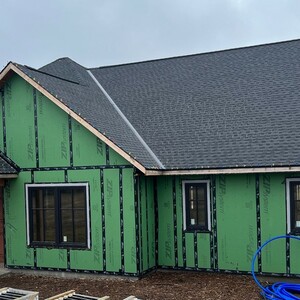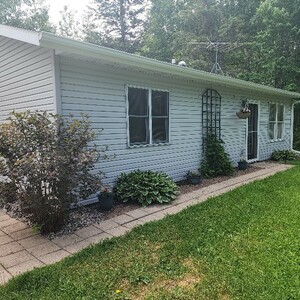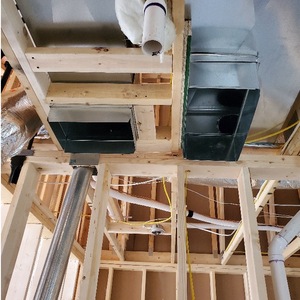
I’ve talked about blower-door testing several times on Green Building Advisor and on my blog, Northern Built. This discussion will dive deeper into when testing should be done, the different testing options, and interpreting the results.
I typically perform four tests: One for code compliance, one during construction, one for contractor diagnostics, and one for homeowner diagnostics. Sometimes I’ll do a fifth test to help identify air leaks.
Code-compliance testing is the most common type of test I conduct. The building code from the 2018 IRC, which applies only to new construction, states:
The building or dwelling unit shall be tested and verified as having an air leakage rate of not exceeding 5 air changes per hour in climate zones 1 and 2, and 3 air changes per hour in climate zones 3 through 8. Testing shall be conducted in accordance with RESNET/ICC 380, ASTM E779 or ASTM E1827 and reported at a pressure of 0.2-inch w.g. (50 pascals.) Where required by the building official, testing shall be conducted by an approved third party. A written report of the results of the test shall be signed by the party conducting the test and provided to the building official. Testing shall be performed at any time after creation of all penetrations of the building thermal envelope.
This code requires all new residential construction pass an air-leakage test of less than 5 or 3 air changes per hour (depending on your climate zone) at 50 pascals. This is a pass/fail test, and is typically performed at the end of construction after all HVAC equipment and plumbing fixtures have been installed. (Plumbing traps should be duct-taped or filled with water prior to running the test—if left open, air will be pulled through the system from the roof vent.) This is the least expensive of all the blower-door tests I conduct;…
Weekly Newsletter
Get building science and energy efficiency advice, plus special offers, in your inbox.

This article is only available to GBA Prime Members
Sign up for a free trial and get instant access to this article as well as GBA’s complete library of premium articles and construction details.
Start Free TrialAlready a member? Log in















12 Comments
Randy,
Fabulous article, thank you for making the connection between ACH50 and CFM50. Both measurements are used and the calculation needs to be understood. Everything I thought about when I read the title, you covered, great work !!
Thank you Doug!
Great explanations and discussion.
I agree that CFM50/(sq. ft.) is a better number to use if we can get people to the point of thinking that way. But I have to admit that with GBA's font, I was thrown for a loop by seeing it written as FT2, since it looks like 2 is the subscript. I think sq. ft. is a better way to write it when the technological capability to write it as ft² isn't available. (There's also a mistake later where it's written SF2, which looks like sulfur difluoride, and translates to square feet squared.)
A question: I agree that it's good not to test when there's vermiculite insulation. On old houses, how do you know? Do you take a peek in the attic before setting up the door, or interview the homeowners?
Hi Charlie, that's my fault with the sq ft2, didn't look for the alternate character like °. As far as the vermiculite, I do ask and check when testing older homes. I've also seen it loose filled at a rim joist, very strange seeing it there. If it's in the walls, chances are I won't catch it unless the homeowners know. Good question.
Randy,
When you have come across it loose filled at rim joists is it part of a balloon framed house? Or just kind of filled in at the joist.
Thanks for the article!
The time I ran into vermiculite at the rim, the home was platform framed, not balloon framed. Someone had installed a 2x inside of the rim joist with a small space between the floor framing and the top of the 2x to allow a space for pouring the vermiculite into the cavity. Someone went through a lot of work getting that space insulated.
Thanks for the question.
Hi Charlie,
Thank you for pointing out that confusion and inconsistency. I've updated the post to reflect your comments. Keep 'em coming...
Randy, good article!
I agree with moving to CFM50/ft² for two reasons. First is that as Martin and others have pointed out it is simply a better and more informative measure.
The other is that it will help us compare ourselves to other countries better. ResNet uses the total envelope interior (including dead space between ceilings & floors) for the volume measurement (denominator) which results in a lower and perceived better ACH50 than other countries who use the actual conditioned space where air is actually changed (floor to ceiling).
A 1.5 ACH50 house in Europe is much tighter than a 1.5 ACH50 house in the U.S.
Also, what are you seeing for houses built within the past 2 or 3 years as far as ACH50? Are they improving each year or have we kind of plateaued?
I'm seeing improvement. The tightest house I had tested three years ago was 1.75ACH50, that's now close to normal for me. I have a few that are less than 1 ACH50. The insulators, who do most of the air sealing in my area are very good. Thanks for the comment!
Perhaps you can send your insulators down to the cities :-)
Are builders in your area beginning to understand how important sealing is as the project progresses rather than as a one-time 'the insulators will do it' thing?
Are you seeing much in the way of exterior insulation? We had planned to do exterior insulation on our house but got hard pushback from architects and builders. They'd be OK at first talking about it but then get cold feet and run back to what they knew.
Thanks for the great article. I like how you provided an example house.
One thing I would be curious about is how quickly surface area increases (relative to volume) as a building design gets more complex? I don't have enough knowledge of building fashions regarding bump-outs, turrets, dormers, courtyards, etc. to guess what is seen in the real world.
We see that ACH50 punishes small home design. Will surface leakage punish simple home design, or is envelope "complexity" not much of a factor?
Edit: I can see that envelope complexity is probably self-limiting as there are more places to make mistakes on the air sealing.
Hi John,
You're right, the more complex the design, the harder it is to air seal. You're also right with very small homes being punished by ACH50, very large volume homes get a break. There is something interesting going on in Washington State's code, they are limiting the ceiling height to 8.5 feet with regards to the volume calculation. An attempt to level the playing field between large volume and small volume homes. Hoping to have an upcoming article that talks more about that code.
The question about the relationship between surface area and volume, I haven't tried to find a correlation between the two. No one I'm doing testing for is paying attention to the CFM/Sq Ft number, I do believe it's a better metric, but the majority of testing I'm conduction only concentrates on the ACH number. I've recently started including the CFM/Sq FT on all my tests, I should start a spreadsheet to track the relationship.
Thanks for the question!
Log in or become a member to post a comment.
Sign up Log in